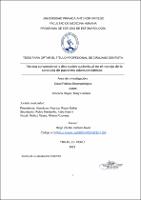Mostrar el registro sencillo del ítem
Técnica convencional y distracción audiovisual en el manejo de la conducta de pacientes odontopediátricos
| dc.contributor.advisor | Mego Zárate, Nelson Javier | |
| dc.contributor.author | Chicana Hoyos, Mary Carmen | |
| dc.creator | Chicana Hoyos, Mary Carmen | |
| dc.date.accessioned | 2024-02-02T20:10:54Z | |
| dc.date.available | 2024-02-02T20:10:54Z | |
| dc.date.issued | 2024 | |
| dc.identifier.uri | https://hdl.handle.net/20.500.12759/19791 | |
| dc.description.abstract | El estudio fue longitudinal, comparativo y experimental en el que se evaluó a 74 estudiantes con 7 y 9 años de edad de comportamiento definitivamente negativo, a quienes se les aplicó una lista de cotejo según escala de Frankl. Este instrumento fue sometido a validación por expertos, el valor obtenido del coeficiente de la V de Aiken es de 1.00 y confiabilidad mediante una calibración donde se hizo un análisis inter-intraevaluador donde el valor obtenido del coeficiente de Kappa de Cohen es de 0.861. Resultados: La técnica de distracción audiovisual fue más eficaz que la técnica convencional. Se obtuvo un 46.9% de conducta definitivamente positiva solo con la técnica convencional y con la técnica audiovisual se obtuvo un 62.5%. La técnica audiovisual es más efectiva en niños con 9 años de edad obteniendo una conducta definitivamente positiva del 81,2%. La técnica audiovisual es más efectiva según sexo masculino y femenino. Conclusión: La técnica de distracción audiovisual es más eficaz que la técnica convencional en el manejo de la conducta de pacientes odontopediátricos. | es_PE |
| dc.description.abstract | The objective of the research was to compare the efficacy of the conventional technique and audiovisual distraction in the behavioral management of pediatric dentistry patients. Methodology: The study was longitudinal, comparative and experimental in which 74 students with 7 and 9 years of age with definitely negative behavior were evaluated, to whom a checklist was applied according to Frankl's scale. This instrument was submitted to validation by experts, the value obtained for Aiken's V coefficient is 1.00 and reliability by means of a calibration where an inter-intra- evaluator analysis was made where the value obtained for Cohen's Kappa coefficient is 0.861. Results: The audiovisual distraction technique was more effective than the conventional technique. A 46.9% of definitely positive behavior was obtained only with the conventional technique and with the audiovisual technique a 62.5% was obtained. The audiovisual technique is more effective in children 9 years of age, obtaining a positive definitive behavior of 81.2%. The audiovisual technique is more effective according to male and female sex. Conclusion: The audiovisual distraction technique is more effective than the conventional technique in the behavioral management of pediatric dentistry patients. | es_PE |
| dc.description.uri | Tesis | es_PE |
| dc.format | application/pdf | es_PE |
| dc.language.iso | spa | es_PE |
| dc.publisher | Universidad Privada Antenor Orrego | es_PE |
| dc.relation.ispartofseries | T_ESTO_1118 | |
| dc.rights | info:eu-repo/semantics/openAccess | es_PE |
| dc.rights.uri | https://creativecommons.org/licenses/by/4.0/ | es_PE |
| dc.subject | Conducta | es_PE |
| dc.subject | Distractor Audiovisual | es_PE |
| dc.title | Técnica convencional y distracción audiovisual en el manejo de la conducta de pacientes odontopediátricos | es_PE |
| dc.type | info:eu-repo/semantics/bachelorThesis | es_PE |
| thesis.degree.grantor | Universidad Privada Antenor Orrego. Facultad de Medicina Humana | es_PE |
| thesis.degree.name | Cirujano Dentista | es_PE |
| thesis.degree.discipline | Estomatología | es_PE |
| dc.subject.ocde | http://purl.org/pe-repo/ocde/ford#3.02.14 | es_PE |
| renati.advisor.orcid | https://orcid.org/0000-0002-8232-4150 | es_PE |
| renati.author.dni | 70585369 | |
| renati.advisor.dni | 21523403 | |
| renati.type | http://purl.org/pe-repo/renati/type#tesis | es_PE |
| renati.level | http://purl.org/pe-repo/renati/level#tituloProfesional | es_PE |
| renati.discipline | 911016 | es_PE |
| renati.juror | Aramburu Vivanco, Rosio Esther | |
| renati.juror | Rubio Membrillo, Katia Noemi | |
| renati.juror | Muñoz Reyes, Miriam Rosmery | |
| dc.publisher.country | PE | es_PE |
Ficheros en el ítem
Este ítem aparece en la(s) siguiente(s) colección(es)
-
Estomatología [567]




